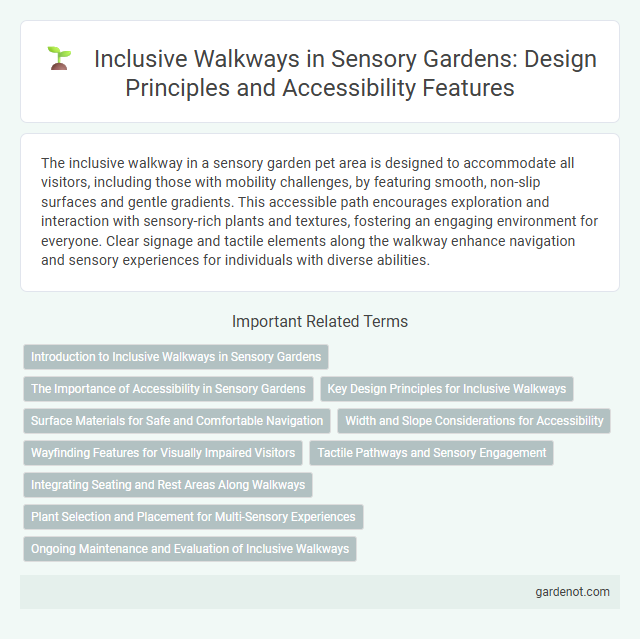The inclusive walkway in a sensory garden pet area is designed to accommodate all visitors, including those with mobility challenges, by featuring smooth, non-slip surfaces and gentle gradients. This accessible path encourages exploration and interaction with sensory-rich plants and textures, fostering an engaging environment for everyone. Clear signage and tactile elements along the walkway enhance navigation and sensory experiences for individuals with diverse abilities.
Introduction to Inclusive Walkways in Sensory Gardens
Inclusive walkways in sensory gardens are designed to accommodate individuals of all abilities, ensuring ease of access and engagement with the environment. These pathways typically feature smooth, non-slip surfaces, tactile paving, and gentle slopes to support wheelchair users and those with mobility challenges. Strategic placement of sensory elements along the walkway enhances interactive experiences through touch, sound, and scent, fostering an inclusive sensory exploration for everyone.
The Importance of Accessibility in Sensory Gardens
Inclusive walkways in sensory gardens are essential for providing equal access to individuals with diverse physical abilities, ensuring everyone can engage with tactile, auditory, and olfactory stimuli. Designing smooth, non-slip surfaces with appropriate width accommodates wheelchairs, walkers, and strollers, enhancing mobility and safety. Accessibility features such as raised garden beds and braille signage empower visitors with visual or mobility impairments to fully experience the therapeutic benefits of the garden environment.
Key Design Principles for Inclusive Walkways
Key design principles for inclusive walkways in sensory gardens emphasize tactile surfaces that accommodate different mobility aids and sensory sensitivities. Contrasting colors and clear edging enhance spatial orientation for individuals with visual impairments, while smooth, non-slip materials ensure safety and comfort for all users. Incorporating varied textures and gradual slopes supports accessibility and sensory engagement universally.
Surface Materials for Safe and Comfortable Navigation
Surface materials in an inclusive walkway within a sensory garden must prioritize safety and comfort, using non-slip, tactile, and shock-absorbing textures to enhance navigability for individuals with diverse sensory and mobility needs. Materials like rubberized, porous pavers or smooth, compacted decomposed granite provide firm footing while minimizing tripping hazards. Incorporating contrasting colors and subtle patterns in the surface design supports spatial orientation and sensory engagement throughout the pathway.
Width and Slope Considerations for Accessibility
An inclusive walkway in a sensory garden should maintain a minimum width of 36 inches to comfortably accommodate wheelchairs and mobility aids, ensuring seamless navigation. Slope considerations are critical, with gradients ideally not exceeding 5% to prevent strain and provide safe access for all users, including those with limited mobility. Smooth, non-slip surfaces complement these dimensions, enhancing overall accessibility and sensory engagement.
Wayfinding Features for Visually Impaired Visitors
The inclusive walkway in the sensory garden incorporates tactile paving and raised patterns to guide visually impaired visitors safely. Braille signage and audio beacons provide essential wayfinding cues, enhancing spatial orientation and independence. Strategically placed contrasting colors and textured surfaces further support navigation by stimulating sensory perception.
Tactile Pathways and Sensory Engagement
Inclusive walkways in sensory gardens feature tactile pathways designed to enhance sensory engagement through varied textures and materials, providing critical navigational cues for individuals with visual impairments. These pathways incorporate raised patterns, different surfaces, and contrasting colors to stimulate the sense of touch and support spatial orientation. Integrating auditory and olfactory elements along tactile routes further enriches the multisensory experience, promoting accessibility and inclusivity.
Integrating Seating and Rest Areas Along Walkways
Integrating seating and rest areas along inclusive walkways in sensory gardens enhances accessibility and comfort for all visitors, including those with mobility challenges. Strategically placed benches with tactile and contrasting materials support users with sensory processing needs and improve wayfinding. These thoughtfully designed rest spots encourage longer engagement and promote social interaction within the garden environment.
Plant Selection and Placement for Multi-Sensory Experiences
Selecting aromatic herbs like lavender and mint, alongside textured plants such as lamb's ear, enhances tactile and olfactory stimulation on an inclusive walkway. Strategic placement of visually contrasting foliage ensures accessibility for visitors with varying visual abilities, while incorporating seasonal blooms supports ongoing sensory variation. This thoughtful plant selection and arrangement create a dynamic environment that engages multiple senses, promoting inclusivity and connection to nature.
Ongoing Maintenance and Evaluation of Inclusive Walkways
Ongoing maintenance of inclusive walkways in sensory gardens ensures safe, accessible surfaces and clear tactile markers for all users, including those with disabilities. Regular evaluation involves assessing path durability, surface texture, and signage clarity, adapting features based on user feedback and environmental changes. Prioritizing these efforts enhances navigation ease, sensory engagement, and overall visitor satisfaction.
Inclusive walkway Infographic

 gardenot.com
gardenot.com